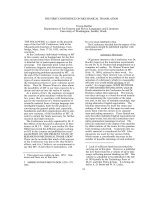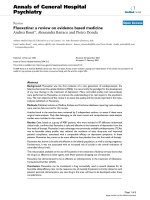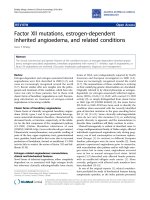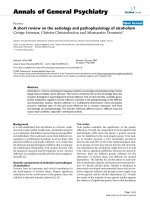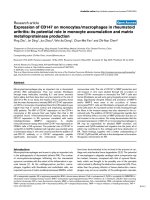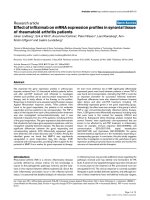Báo cáo y học: " 12th international conference on human retrovirology: HTLV and related retroviruses" doc
Bạn đang xem bản rút gọn của tài liệu. Xem và tải ngay bản đầy đủ của tài liệu tại đây (220.22 KB, 6 trang )
BioMed Central
Page 1 of 6
(page number not for citation purposes)
Retrovirology
Open Access
Short report
12
th
international conference on human retrovirology: HTLV and
related retroviruses
Michael D Lairmore*
1,2,3
and Masahiro Fujii
4
Address:
1
Department of Veterinary Biosciences and Center for Retrovirus Research, The Ohio State University, Columbus, OH 43210 USA,
2
Comprehensive Cancer Center, The Ohio State University, Columbus, OH 43210 USA,
3
Department of Molecular Virology, Immunology, and
Medical Genetics, The Ohio State University, Columbus, OH 43210 USA and
4
Division of Virology, Niigata University Graduate School of Medical
and Dental Sciences 1-757, Asahimachi-Dori Niigata, Niigata 951-8510 Japan
Email: Michael D Lairmore* - ; Masahiro Fujii -
* Corresponding author
Abstract
The 12
th
International Conference on Human Retrovirology: HTLV and Related Retroviruses, was
held at the Half Moon Hotel in Montego Bay, Jamaica, from June 22
nd
to June 25
th
2005. The
scientific conference, sponsored by the International Retrovirology Association, is held biennially
at rotating international venues around the world. The meeting brings together basic scientists,
epidemiologists and clinical researchers to discuss findings to prevent HTLV infection or develop
new therapies against HTLV-mediated diseases. The Association fosters the education and training
of young scientists to bring new approaches to the complex problems of HTLV research, such as
translational research to bring findings from the laboratory into clinical trials that benefit HTLV-
infected patients. The breadth and quality of research presentations and workshops at the 12
th
International Conference indicate that these goals are being accomplished. As HTLV research
enters its third decade a new generation of scientists face many challenges. However, HTLV
scientists and clinicians displayed exciting new approaches and discoveries during plenary talks and
poster sessions. The conference encouraged research in HTLV infections and disease, fostered
collaborations, and stimulated new partnerships between clinicians and scientists to encourage
clinical trials and novel therapeutic interventions.
Findings
Jamaica and the International HTLV Conference
The International Retrovirology Association in conjunc-
tion with the National Institutes of Health and the Univer-
sity of the West Indies, Jamaica welcomed over 300
scientists from diverse disciplines to the 12
th
International
Conference on Human Retrovirology: HTLV and Related
Retroviruses, held at the Half Moon Hotel in Montego
Bay, Jamaica, from June 22
nd
to June 25
th
2005. The Asso-
ciation was established in May 1994 to promote informal
discussions among established human T-lymphotropic
viruses (HTLV) scientists to enhance the efforts of scien-
tists and clinicians to form interdisciplinary groups to
study HTLV and its related diseases in a cooperative and
creative manner. The Association sponsors its biennial
general scientific conferences at rotating international
venues, generally in areas with endemic HTLV infection.
This unique meeting brings together basic scientists, epi-
demiologists and clinical researchers in a free form
exchange of data to discuss approaches to prevent HTLV
infection or develop new therapies against HTLV-medi-
ated diseases. The Association has focused its interna-
Published: 04 October 2005
Retrovirology 2005, 2:61 doi:10.1186/1742-4690-2-61
Received: 20 September 2005
Accepted: 04 October 2005
This article is available from: />© 2005 Lairmore and Fujii; licensee BioMed Central Ltd.
This is an Open Access article distributed under the terms of the Creative Commons Attribution License ( />),
which permits unrestricted use, distribution, and reproduction in any medium, provided the original work is properly cited.
Retrovirology 2005, 2:61 />Page 2 of 6
(page number not for citation purposes)
tional meeting on HTLV and other related human and
nonhuman primate retroviruses, to promote excellent sci-
ence and to facilitate the communication of scientific
results. Equally important, the Association fosters the edu-
cation and training of young scientists to bring new
approaches to the complex problems of HTLV research,
such as translational research to bring findings from the
laboratory into clinical trials that benefit HTLV-infected
patients. Judging from the breadth and quality of research
presentations and workshops at the 12
th
International
Conference, these goals are being accomplished.
HTLV research enters its third decade with the challenge to
bring a new generation of scientists to the challenges fac-
ing the field [1]. Many of the scientists attending the meet-
ing were from developing countries where HTLV is
endemic. It was particularly relevant that the conference
was held in context to the 25
th
anniversary of the discovery
of the first identified human retrovirus, HTLV-1. Scientists
in this field of research have many new discoveries to
energize their work, many of which were on display dur-
ing the meeting as plenary talks or during poster sessions.
The conference encouraged research in HTLV infections
and disease and fostered collaborations between research
groups. Importantly, the conference through its many
workshops provided a setting to stimulate new partner-
ships between clinicians and scientists to encourage the
development of clinical trials and novel interventions.
Human T-lymphotropic virus type 1 (HTLV-1) and the
closely related HTLV-2 were the first human retroviruses
discovered [2]. HTLV-1, is a member of the deltaretrovirus
genera, and infects approximately 15 to 20 million people
around the world [3]. HTLV-1 infection occurs world-
wide, but is particularly endemic in Central Africa, the
Caribbean, and South America and southwestern Japan,
while HTLV-2 is endemic among Indian tribes of South,
Central, and North America. The virus causes adult T cell
leukemia/lymphoma (ATLL), an aggressive malignancy of
CD4+ T lymphocytes in 1 to 5% of infected individuals
that is refractory to most therapies [4]. HTLV-1 is also
associated with a progressive neurologic disease termed
HTLV-1-associated myelopathy/tropical spastic parapare-
sis (HAM/TSP) and a variety of chronic inflammatory dis-
eases including infectious dermatitis, uveitis, and
arthropathy [5,6]. The following summarizes selected key
presentations at the 12
th
International Conference on
Human Retrovirology, but is by no measure a comprehen-
sive overview of all of the exciting findings from the con-
ference and we apologize in advance to those investigators
we have not mentioned in an effort to provide a concise
summary of the meeting.
Molecular Epidemiology of HTLV Infections:
New Insights
Reports of well characterized cohorts by Dr. Edward Mur-
phy of the University of San Francisco (United States)
began the meeting with a clear challenge to carefully
examine the relationship between viral loads and disease
outcomes. Data from these groups suggest that a "set
point" of viral load is determined in each individual stud-
ied based on their ability to form an effective early
immune response to the infection. Risk factors for the
transmission of HTLV-1 from infected mothers to their
children based on HLA haplotype was presented by Dr.
Robert Biggar and colleagues (National Institutes of
Health, United States), who illustrated how immune rec-
ognition may determine rates of viral transmission.
A highlight of this session included Dr. Masao Matsuoka's
and colleagues' (Kyoto University, Japan) recent findings
related to the functional significance of an anti-sense mes-
sage that codes for the protein HBZ and the role of meth-
ylation in the control of HTLV-1 gene expression. His
group provided data to indicate that proviral DNA in cell
lines derived from ATLL patients was highly methylated
correlating with low or absent HTLV-1 gene expression.
Unlike the 5' LTR of proviral DNA and the coding region
and the 3' LTR was not heavily methylated in these same
cells. The expression of HBZ mRNA, but not those encod-
ing other viral genes such as tax, was detected in all the
fresh ATL samples, strongly suggesting that HBZ has a sig-
nificant role in leukemic cell survival in vivo. These find-
ings were further supported subsequently in the meeting
by Dr. Eric Wattel (Lyon Rhone, France) who also found
correlation between proviral loads in patients with HBZ
mRNA expression. In addition, it appears that HBZ
expression had a growth stimulating influence on ATL
cells. Transfection of HBZ expressing plasmids in an IL-2
dependent human T-cell line augmented the cell line
growth and inhibition of HBZ expression by siRNA inter-
ference reduced cell growth of ATL-derived cell lines.
Finally, transgenic mice containing HBZ gene under the
control of a CD4 promoter exhibited an increased
number of CD4+ spleen-derived T-cells. Dr. Matsuoka
proposed that HBZ and Tax act synergistically to trans-
form CD4+ T-cells eventually leading to the development
of ATLL. Since HBZ, but not Tax is expressed in ATL cells
in vivo, this unique anti-sense encoded nonstructural pro-
tein may represent a promising therapeutic target in ATLL
patients. Later in the meeting, the HBZ encoding region
was further characterized and mapped to reveal new start
sites for the anti-sense transcript by Dr. M. Cavanagh and
colleagues (CHUL Research Center, Canada). Collec-
tively, these presentations provide new insights into the
complex interaction between HTLV-1 and virus replica-
tion and lymphocyte survival.
Retrovirology 2005, 2:61 />Page 3 of 6
(page number not for citation purposes)
An exciting summary of recently published findings about
novel nucleotide sequences of human retroviruses, HTLV-
3 and HTLV-4 were summarized by Dr. William Switzer of
the United States Centers for Disease Control and Preven-
tion. These researchers used polymerase chain detection
to discover evidence of two related HTLVs (named HTLV-
3 and HTLV-4). The first group directed by Switzer inves-
tigated 930 central Africans with contact with nonhuman
primate blood through hunting and butchering. Serologi-
cal tests and partial DNA sequencing of blood samples
showed that two humans were infected with novel
viruses, designated HTLV-3 and HTLV-4. Phylogenetic
analysis showed that HTLV-3 is originated from a known
monkey virus STLV-3 through cross-species transmission,
while a corresponding monkey virus to HTLV-4 has not
been reported yet and genetically equidistant from all
known HTLVs/STLVs. The second group directed by Dr.
Antoine Gessain (Pasteur Institute, France) tested serum
specimens or DNA from 240 subjects from Cameroon to
provide suggestive evidence that an HTLV-3 related to
STLV-3 was present in individuals exposed to nonhuman
primate blood or tissues. Importantly, these findings sug-
gest that cross species transmission between nonhuman
primates and humans is ongoing where people are
exposed to primate blood and tissues [7,8]. A challenge to
researchers in the field in the coming years will be to fully
characterize these new viruses in terms of complete
genomic sequences and to identify replication or patho-
genic mechanisms of HTLV-3 and HTLV-4 compared to
HTLV-1 and HTLV-2.
Basic Biology: Novel Mechanisms of
Transformation and Disease
The study of HTLV-1 Tax initiated the concept that com-
plex retroviruses regulate their expression by producing
transactivating proteins. The mechanisms used by HTLV-
1 Tax to alter cell cycle regulation or cell division, as in
past meetings, continued to dominate the basic biology
sessions of the 2005 meeting. Dr. Jennifer Nyborg (Colo-
rado State University, United States) provided an over-
view of how the well-studied transactivating protein of
HTLV-1, Tax, promotes viral transcription from the chro-
mosomally-integrated HTLV-1 promoter. By using chro-
matin immunoprecipitation analysis, Dr. Nyborg's group
provided data that the promoter activation by Tax1 corre-
lated with the apparent loss of nucleosomes from the pro-
moter and coding region. These results suggest that the
Tax functions by causing nucleosome removal from the
HTLV-1 promoter. Later in the meeting, by using in vitro
transcription using "chromatinized" templates, Dr. Fatah
Kashanchi (George Washington University, United States)
presented complementary data indicating that Tax con-
verts the randomly-assembled nucleosomes into periodic
assembled ones, and this periodic assembly of the nucle-
osomes correlated with the activation of HTLV-1 pro-
moter by Tax. His group has previously demonstrated that
Tax recruits SWI/SNF complex containing BRG1 on the
HTLV-1 promoter, and the recruitment is essential for the
transcriptional activation of HTLV-1 promoter [9]. Thus,
SWI/SNF containing BRG1 may play a role in the reassem-
ble of nucleosomes with the HTLV-1 promoter. Dr. Susan
Marriott (Baylor University, United States) provided new
data on the effects of HTLV-1 Tax on cell cycle progression
and genomic instability. Tax appears to increase genomic
instability by altered key checkpoints in the cell cycle. Her
work has focused on the G1 and S phases of the cell cycle.
Dr. Kuan-Teh Jeang (National Institutes of Health, United
States) presented data that continued this theme of the
meeting. His new findings suggest that Tax interacts with
the Ran-GTP network to cause abnormal amplification of
cellular centrosomes, which may be an initial event of
cancer caused by the virus. Dr. Patrick Green (Ohio State
University, United States) furthered this subject area by
providing new information about the role of the anti-
sense encoded protein, PDZ-binding motif of Tax in
induction of micronuclei, a hallmark of genomic instabil-
ity. Dr. Chou-Zen Giam (Uniformed Services University,
United States) reported that "unscheduled" activation by
the Cdc20-associated anaphase promoting complex by
HTLV-1 Tax induces mitotic dysfunction and inactivation
of critical regulators of mitosis. This presentations overall
solidified the concept that the acquisition of genetic and
epigenetic changes in Tax-expressing T cells favors the
selection of cells with mutated proviral DNA in a manner
to favor eventual outgrowth of the transformed cell in a
way that avoids immune system recognition. Collectively,
the precise role of Tax in cellular transformation was a
major theme of the basic science sections of the meeting.
Dr. Warner Greene (Gladstone Institute, United States)
provided a stimulating plenary talk about the role of
APOBEC 3G (A3G), a cellular deoxycytidine deaminase
with broad anti-retroviral activity. Dr. Greene summa-
rized what is currently understood about A3G, which is
inactive as a high-molecular-weight ribonucleoprotein
complex in activated CD4 T-cells, but is active in low-
molecular-weight complexes in resting CD4 T-cells. Rest-
ing CD4+ T-cells are typically resistance for HIV-1 infec-
tion, but the resistance was greatly relieved by A3G-
specific siRNAs that block A3G function. Surprisingly,
sequence analysis showed rare dG-dA hypermutations, a
signature of A3G-mediated inhibition, in infected CD4 T-
cells. Thus, A3G may have another mechanism to inhibit
HIV infection. Dr. Greene suggested that deaminase activ-
ity may have a broader role and perhaps may influence
HTLV-1's ability to infected CD4+ T-cells, a preferred nat-
ural target of HTLV-1 infection in vivo. In this regard, Dr.
David Derse and colleagues (National Cancer Institute,
United States) at the meeting reported that exogenous
Retrovirology 2005, 2:61 />Page 4 of 6
(page number not for citation purposes)
overexpression of APOBEC 3B (A3G) also inhibited
HTLV-1 infectivity. A3G was incorporated into HTLV-1
virions, but the amount was much less than that of HIV-1
stains that lack the ability to inactive the cellular co-factor
(HIV Vif defective). Interestingly, HTLV-1 does not appear
to have vif-like gene in its genome, but data presented
from Dr. Derse suggested that the HTLV-1 structural gene,
gag contained sequences that act to inhibit A3G incorpo-
ration into HTLV-1 virions. Thus, HTLV-1 may overcome
A3G anti-retroviral activity through gag-mediated exclu-
sion of A3G. Consistently with these results are findings
that indicate that there are rare dG-dA hypermutations
among HTLV-1 isolates.
Clinical and Translational Research: New
Approaches in Therapy
The meeting brought together a variety of clinicians seek-
ing better treatments against ATLL and HAM/TSP. Dr.
Thomas Waldmann (National Institutes of Health,
United States), a pioneer in the field of therapeutic
approaches against ATLL, provided a summary of the role
of IL-15 in T-cell signaling and his groups recent findings
involving Hu-Mik-Beta-1 (HM-beta) to block β-chain sig-
naling following IL-15 receptor engagement. This
approach may provide exciting new avenues to inhibit
lymphocyte-mediated disorders such as HAM/TSP. Clini-
cal trials using the potent immunosuppresive agent Cam-
path-1H (anti-CD52) was presented by Dr. J.C. Morris
(National Institutes of Health, United States). HTLV-1
Leukemic patients appeared to respond well to Campath-
1H, despite its adverse side effects. A key factor in non-
responsive ATL lymphoma patients appears to be the dif-
ficulties with drug penetration of solid tissues.
HTLV-1 Tax has been shown to interact directly with dif-
ferent members of the NF-κB family [10]. Interference
with post-translational modifications of Tax including
ubiquitylation and sumoylation by proteasome inhibi-
tion was presented by Dr. Ali Bazarbachi and colleagues
(American University, Beirut, Lebanon) as effective ways
to block NF-κB signaling, a key pathway of Tax-mediated
cell transformation. Dr. Lee Ratner (Washington Univer-
sity, United States) presented new data regarding his
novel transgenic mouse model. His new work indicates
from this model indicates that both the canonical and
non-canonical pathways of NF-κB activation are involved
in resistance to apoptotic stimuli in Tax transgenic mouse
derived cell lines.
Novel treatments continue to be a focus of researchers in
the HTLV and related retrovirus field. Dr. Luc Willems and
colleagues (Faculte Universitaire des Sciences
Agronomiques, Belgium) using their established bovine
leukemia virus infection of sheep model, revealed new
approaches to treatment of leukemia using the drug, val-
proate. This treatment was shown to be effective in
decreasing lymphocyte numbers and tumor regression in
this model system.
Educational and Technical Workshops: Bringing
Scientists together to Address Complex
Problems
A particularly interactive portion of the meeting were the
educational and technical workshops held offsite at the
Barnett Estates, a serene setting that promoted scientific
exchange. Morning workshops discussed the epidemiol-
ogy, animal models, immunology, and basic virology of
HTLV and related viruses. These group sessions were spir-
ited and were lead by scientist who provided an excellent
overview of their fields before leading the discussion of
selected topics of interest to the group. These sessions
allowed a more informal exchange of ideas and unpub-
lished data, a goal of any scientific meeting. New virus
strains including HTLV-3 and HTLV-4 characterized by
molecular signatures were the subject of many conversa-
tions. Current strengths of weakness or gaps in the litera-
ture dominated many sessions as participants provided
their interpretation of recent published or new data at the
early plenary sessions. These workshops were extended in
the afternoon to include important and clinically focused
sessions based on HTLV disease associations. Thus, work-
shops devoted to adult T-cell leukemia/lymphoma, infec-
tious dermatitis, and HTLV-1 neurologic disease allowed
scientist to debate current approaches and how clinical tri-
als could be evaluated and improved. Overall, these work-
shops provided a dynamic interaction among scientists
and clinicians, which were apparent when patient case
studies were included to focus the discussions.
Viral Pathogenesis: Interplay between HTLV's
and Lymphocytes
Dr. Masahiro Fujii and colleagues (Niigata University, Nii-
gata, Japan) reported data using co-transfection assays of
Tax expression plasmids with luciferase reporters to test
the functional differences between HTLV-1 and HTLV-2
Tax [11]. This group's results suggest that IL-2 autocrine
secretion establishes benign life-long HTLV-2 infection
and the distinct cytokine production regulated by the
nuclear factor of activated T-cells (NFAT) is a key factor for
the distinct differences in disease association between
these two related viruses. Further insights into the patho-
genesis of HTLV-1 infection was provided by Dr. Brian
Wigdahl (Drexel University, United States) who provided
provocative data indicating that Tax is not only secreted
from infected cells, but can differentially modulate the
function of dendritic cells and astrocytes. This work may
provide a unique mechanism of neurologic damage by
HTLV-1. Dr. Renaud Mahieux and colleagues (Institut
Pasteur, France) continued to implicate unique molecular
features that differentiate HTLV-1 Tax (Tax-1) from HTLV-
Retrovirology 2005, 2:61 />Page 5 of 6
(page number not for citation purposes)
2 Tax (Tax-2). Tax-2 appears to have a distinct cytoplasmic
distribution compared to Tax-1. Futures studies to define
the role of particular motifs that may explain the patho-
genic differences between HTLV-1 and HTLV-2 will be
directed at these important regulatory proteins.
Dr Claudine Pique and colleagues (Saint Louis Hospital,
Paris, France) presented new findings that neuropilin 1
(NP-1), a receptor for Sematophorin 3a and vascular
endothelial growth factor (VEGF), acts as a co-factor for
HTLV-1 entry. NP-1 directly interacted with HTLV-1 enve-
lope protein. There appears to be two separable domains
in the HTLV-1 envelope that are required for the virus
entry. While one domain is a binding surface for GLUT-1,
a recently identified HTLV-1 receptor, the other was that
for NP-1. NP-1, GLUT-1 and the envelope proteins appear
to form a ternary complex on the cell surface. These results
argued that HTLV-1 has two cellular receptors for the viral
entry into host cells similar to HIV-1.
Dr. Steven Jacobson (National Institutes of Health,
United States) presented new information about the
intriguing findings related to regulatory T-cells (CD4+,
CD25+, Foxp3+) in the immunopathogenesis of HTLV-1-
associated neurologic disease. Interestingly, his research
group found that Tax specifically inhibits foxp3 expres-
sion, which would be predicted to suppress the function
of these important regulatory T-cells, perhaps contribut-
ing to lymphocyte-driven diseases. Dr. Charles Bangham
(University of London, United Kingdom) and his research
group continue to lead the field of cellular immunity
against HTLV-1 infection. His presentation provided
novel insights into the efficiency of cytotoxic T-cell killing
as a key determinant of patient viral load outcome and
data describing unique lymphocyte labeling techniques
(6,6-D(2)-glucose) to monitor the kinetics of lymphocyte
proliferation and death in HTLV-1-infected subjects.
The role of nonstructural proteins including proteins
included in pX ORFs 1 and 2 were featured by a number
of investigators. Dr. Franchini's research group (National
Cancer Institute, United States) presented work indicating
that p12
I
is recruited to the immunological synapse and
inhibits signaling from the T-cell receptor. Dr. Vincenzo
Ciminale (University of Padova, Padova, Italy) provided
an update of his research of a novel mitochondrial local-
izing protein p13
II
in modifying lymphocyte survival and
apoptotic cell death. Dr. Michael Lairmore and his col-
leagues (Ohio State University, United States) provided
new information on the role of p30
II
in modifying G2 exit
of the cell cycle furthering implicating this protein in lym-
phocyte survival.
Conclusions and Perspective
The meeting concluded with poignant remarks by one of
the pioneering epidemiologist in the field of HTLV
research, Dr. Nancy Mueller (Harvard, United States). She
provided appropriate context to past studies of cohorts of
HTLV-1 infected subjects, disease associations, and the
useful applications of carefully controlled population-
based studies. As the meeting came to a close, it was clear
that HTLV and related retrovirus researchers faces many
challenges, which confound and frustrate scientists in the
HTLV field. However, the 12
th
International Conference
on Human Retrovirology illustrated the dedication of the
many scientists, clinicians, and patient advocates to
address these challenges with a new determination and
energy, as they all reluctantly left the gracious atmosphere
of Jamaica to travel back to their homes, laboratories and
offices throughout the world.
List of Abbreviations
HTLV, human T-lymphotropic viruses
HTLV-1, human T-lymphotropic virus type 1
HTLV-2, human T-lymphotropic virus type 2
HAM/TSP, HTLV-1-associated myelopathy/tropical spas-
tic paraparesis
ATLL, adult T-cell lymphoma/leukemia
Competing interests
The authors have no competing financial or other inter-
ests involved in the data, methods, or writing of this man-
uscript.
Authors' contributions
Each author (MF and ML) have each met the definition of
author as outlined by the Retrovirology journal. Each has
made substantive intellectual contributions to the com-
mentary. Each author has given final approval of the ver-
sion to be published. Each author has participated
sufficiently in the work to take public responsibility for
appropriate portions of the content.
Acknowledgements
We thank Beverly Cranston for technical and logistic assistance in the
organization of the International Retrovirology Conference 2005, other
members of the conference organizing committee including Drs. Edward
Murphy (University of San Francisco), Steven Jacobson (NIH), Genoveffa
Franchini (NIH), Graham P. Taylor (Imperial College, UK), Barrie Hanchard
and Owen Morgan (University of the West Indies, Jamaica), Michie Hisada
(NIH), William Hall (University College, Dublin, Ireland), Mark Beilke
(Tulane University, New Orleans, LA, USA), and Steven Foung (Stanfored
University, Stanford, CA, USA). We thank the National Institutes of Health
for R13 conference grants to support the International Retrovirology Con-
ference.
Publish with BioMed Central and every
scientist can read your work free of charge
"BioMed Central will be the most significant development for
disseminating the results of biomedical research in our lifetime."
Sir Paul Nurse, Cancer Research UK
Your research papers will be:
available free of charge to the entire biomedical community
peer reviewed and published immediately upon acceptance
cited in PubMed and archived on PubMed Central
yours — you keep the copyright
Submit your manuscript here:
/>BioMedcentral
Retrovirology 2005, 2:61 />Page 6 of 6
(page number not for citation purposes)
References
1. Yoshida M, Jeang KT: Preface to 25 years of HTLV-1 and ATL
research. Oncogene 2005, 24:5925.
2. Gallo RC: The discovery of the first human retrovirus: HTLV-
1 and HTLV-2. Retrovirology 2005, 2:17.
3. Proietti FA, Carneiro-Proietti AB, Catalan-Soares BC, Murphy EL:
Global epidemiology of HTLV-I infection and associated dis-
eases. Oncogene 2005, 24:6058-6068.
4. Takatsuki K: Discovery of adult T-cell leukemia. Retrovirology
2005, 2:16.
5. Franchini G, Nicot C, Johnson JM: Seizing of T cells by human T-
cell leukemia/lymphoma virus type 1. Adv Cancer Res 2003,
89:69-132.
6. Osame M: Pathological mechanisms of human T-cell lympho-
tropic virus type I-associated myelopathy (HAM/TSP). J Neu-
rovirol 2002, 8:359-364.
7. Wolfe ND, Heneine W, Carr JK, Garcia AD, Shanmugam V, Tamoufe
U, Torimiro JN, Prosser AT, Lebreton M, Mpoudi-Ngole E,
Mccutchan FE, Birx DL, Folks TM, Burke DS, Switzer WM: Emer-
gence of unique primate T-lymphotropic viruses among cen-
tral African bushmeat hunters. Proc Natl Acad Sci U S A 2005,
102:7994-7999.
8. Calattini S, Chevalier SA, Duprez R, Bassot S, Froment A, Mahieux R,
Gessain A: Discovery of a new human T-cell lymphotropic
virus (HTLV-3) in Central Africa. Retrovirology 2005, 2:30.
9. Kashanchi F, Brady JN: Transcriptional and post-transcriptional
gene regulation of HTLV-1. Oncogene 2005, 24:5938-5951.
10. Hall WW, Fujii M: Deregulation of cell-signaling pathways in
HTLV-1 infection. Oncogene 2005, 24:5965-5975.
11. Niinuma A, Higuchi M, Takahashi M, Oie M, Tanaka Y, Gejyo F, Tan-
aka N, Sugamura K, Xie L, Green PL, Fujii M: Aberrant activation
of the interleukin-2 autocrine loop through the nuclear fac-
tor of activated T cells by nonleukemogenic human T-cell
leukemia virus type 2 but not by leukemogenic type 1 virus.
J Virol 2005, 79:11925-11934.

